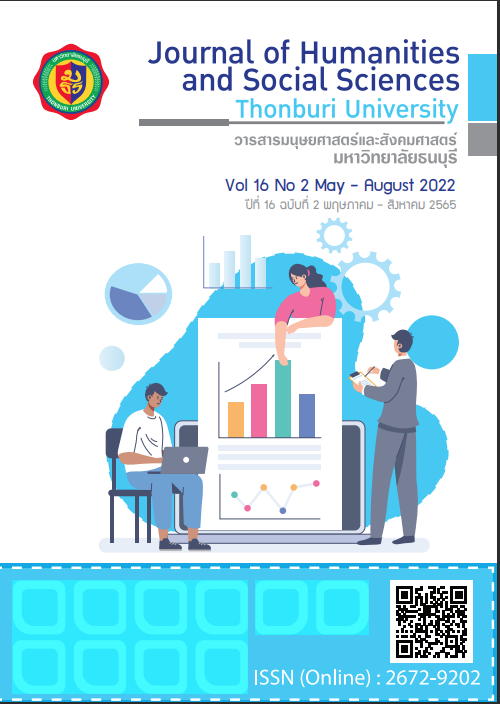The influence of innovative organization climate on innovative work behavior through workplace happiness and generation of employee as a moderated
Keywords:
Innovative organization climate, Innovative work behavior, Workplace happinessAbstract
This study aims to investigate 1) the mediation effect of workplace happiness on the impact of innovative organization climate on innovative work behavior, and 2) the moderated effect of employees’ generation on the relationship between workplace happiness and innovative work behavior. Questionnaire was distributed to 394 full-time employees of the private organizations in Thailand. The results found that workplace happiness is the partial mediator in the relationship between innovative organization climate and innovative work behavior, and employees’ generation moderated the relationship between workplace happiness and innovation work behavior at statistical level of 0.05. These results are useful for the organization in creating an innovative organization climate, which is essential for encouraging innovative work behavior of employees.
References
จิตรลดา พันธุ์พณาสกุล; และ วรลักษณ์ ลลิตศศิวิมล. (2562). การสร้างความได้เปรียบทางการแข่งขันด้วยเทคโนโลยีสารสนเทศและนวัตกรรมของธุรกิจโรงแรมในประเทศไทย : การทบทวนวรรณกรรม. วารสารบริหารธุรกิจเทคโนโลยีมหานคร. 16(2): 19-39.
Abdullah, A. G. K., Y. Ling, C. S. Ping; & Z. B. Yusoff. (2016). The Influence of Workplace Happiness towards Innovative Behavior and Affective Commitment Among the Teachers In Northern Peninsular Malaysia. RA Journal of Applied Research. 2(4): 445-450.
Bani-Melham, S.;& R. Zeffane. (2017). Determinants of employees’ innovative behavior. International Journal of Contemporary Hospitality Management. 30(3): 1601-1620.
Carmeli, A., Meitar, R.;& Weisberg, J. (2006). Self-leadership skills and innovative behavior at work. International Journal of Manpower. 27(1): 75–90.
Chatchawan. R; K. Trichandhara; & R. idsaratt. (2017). Factors Affecting Innovative Work Behavior of Employees in Local Administrative Organizations in the South of Thailand. International journal of social sciences and management. 4(3): 154-157
Cochran, W.G. (1977). Sampling Techniques. 3rded. New York: John Wiley & Sons.
Diener, E. (2003). Subjective Well-Being. Psychological Bulletin. 95(3): 542-575.
Fisher, C. D. (2010). Happiness at Work. International Journal of Management Reviews. 12(4): 384-412.
Hami, A. E.;& M. Batubara. (2018). The Role of Employee Work Happiness towards Innovative Work Behavior Among Lecturers in Indonesia. 10th International Conference on Language, Humanities, Education and Social Sciences. 36-41.
Ibrahim, H. I., W. M. W. Mohamad and K. A. M. Shah. (2018). Organizational Innovative Climate as a Predictor of Innovative Behaviour among Engineers in the Electrical and Electronic Manufacturing Industry. Review of Integrative Business and Economics Research. 7(2). 1-14.
Imran, R., T. Saeed, M. Anis-ul-Haq; & A. Fatima. (2010). Organizational climate as a predictor of innovative work behavior. African Journal of Business Management. 4(15): 3337-3343.
Janssen, O. (2000). Job demands, perceptions of effort-reward fairness and innovative behavior. Journal of Occupational and Organizational Psychology. 73: 287-302.
Munir, R.; & L. S. Beh. (2019). Measuring and enhancing organisational creative climate, knowledge sharing, and innovative work behavior in startups development. The Bottom Line. 32(4): 269-289
Nunnally, J. C. (1978). Psychometric theory. New York: McGraw-Hill Inc.
Sarwar, A., M. K. Imran, Z. Anjum and U. Zahid. (2020). How innovative climate leads to project success: the moderating role of gender and work culture. Innovation & Management Review. 17(4): 413-430.
Stevens, J. (1992). Applied multivariate statistics for the social sciences. 2nded. Lawrence Erlbaum Associates, Inc.
Woodman, R. W. (2008). Creativity and Organizational Change: Linking Idea and Extending Theory. Handbook of Organization Creativity. New York: Taylor & Francis Group.
Wuryanti, K.; & W. O. Surian. (2018). Achieving sustainable competitive advantage through product innovation and market driving. Asia Pacific Management Review. 23: 186-192.
Zemke, R.; C. Raines, & B. Filipczak. (2000). Generations at Work: Managing the Clash of Veterans, Boomers, Xers, and Nexters in Your Workplace. New York: AMA Publications.
Translated Thai References
Phanpanasakul, J.; & W. Lalitsasivimon. (2019). Creating Competitive Advantage with Information Technology and Innovation of Hotel Business in Thailand: Literature Review. MUT Journal of Business Administration. 16(2): 19-39. (in Thai)
Downloads
Published
How to Cite
Issue
Section
License
Copyright (c) 2022 Sukmongkol Lertpiromsuk

This work is licensed under a Creative Commons Attribution-NonCommercial-NoDerivatives 4.0 International License.
ผลงานที่ปรากฎในวารสารฉบับนี้เป็นลิขสิทธิ์เฉพาะส่วนบุคคลของผู้เขียนซึ่งต้องรับผิดชอบต่อผลทาง กฎหมายที่อาจเกิดขึ้นได้และไม่มีผลต่อกองบรรณาธิการ






